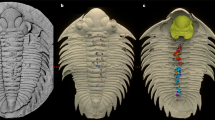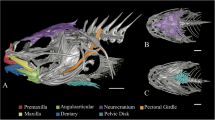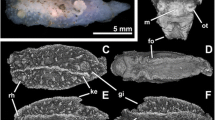Abstract
Isopoda (Crustacea, Peracarida) from the deep sea are relatively well studied but little is known about their lifestyles or the functional morphology and anatomy. The isopod family Macrostylidae, for example, is rather small in size, usually less than 1 cm in body length, and occurs mainly in the deep sea between 3000–6000 m. This family features a paired subepidermal structure on the posterior end of the pleotelson. It has been reported only in this family and was first mentioned by Hansen in 1916, who hypothesised that it represents a pair of statocysts. Nevertheless, neither the structure nor the function has been investigated until now. The shape of some related features, however, has already been used for species differentiation thus indicating that phylogenetically as well as systematically valuable information may be inherent in this feature. Here, the anatomy of this structure was studied based on four species of Macrostylidae from the North Pacific and Atlantic Oceans. It was digitally reconstructed from histological sections. The paired structure comprised two tergal invaginations, each with distinct muscular attachments and a modified seta that distally held a statocyst on the shaft. This resembles equilibrium organs reported from other organisms and thus the statocysts hypothesis seems reliable. Using energy-dispersive X-ray spectroscopy, the substance of the statolith could be determined as silicon dioxide. Based on these findings, the function of this organ and its potential phylogenetic and ecological implications are discussed.





Similar content being viewed by others
Change history
04 November 2017
Unfortunately, Table 1 was incorrectly published in the original version and the same is corrected here in this erratum. The original article was corrected.
References
Alverdes F (1926) Stato-, Photo- und Tangoreaktionen bei zwei Garneelenarten. Z F vergl Physiologie 4:699–765. doi:10.1007/BF00342381
Beer DT (1898) Vergleichend-physiologische Studien zur Statocystenfunction. Pflüger, Arch 73:1–41. doi:10.1007/BF01666178
Birstein JA (1963) Deep Sea Isopod Crustaceans of the Northwestern Part of the Pacific Ocean. Institute of Oceanology, Academy of Sciences, USSR, Moscow
Birstein JA (1970) New Crustacea Isopoda from the Kurile-Kamchatka Trench area. In: Bogorov VG (ed) Fauna of the Kurile-Kamchatka Trench and its environment. Academy of Sciences of the USSR, Moscow, pp 308–356
Birstein JA (1973) Deep water isopods (Crustacea. Isopoda) of the north-western part of the Pacific Ocean—Translated from Birstein 1963. Akademiya Nauk, SSSR, Moscow
Bober S, Riehl T, Henne S, Brandt A (in press) New Macrostylidae (Isopoda) from the Northwest Pacific Basin described by means of integrative taxonomy with reference to geographical barriers in the abyss. Zool J Linn Soc 1–53. doi:10.1093/zoolinnean/zlx042
Brandt A, Malyutina MV (2015) The German-Russian deep-sea expedition KuramBio (Kurile Kamchatka biodiversity studies) on board of the RV Sonne in 2012 following the footsteps of the legendary expeditions with RV Vityaz. Deep Sea Res Part II 111:1–9. doi:10.1016/j.dsr2.2014.11.001
Brandt A, Linse K, Schüller M (2009) Bathymetric distribution patterns of Southern Ocean macrofaunal taxa: bivalvia, Gastropoda, Isopoda and Polychaeta. Deep Sea Res Part I 56:2013–2025. doi:10.1016/j.dsr.2009.06.007
Brandt A, Elsner N, Brenke N et al (2013) Epifauna of the Sea of Japan collected via a new epibenthic sledge equipped with camera and environmental sensor systems. Deep Sea Res Part II 86–87:43–55. doi:10.1016/j.dsr2.2012.07.039
Brenke N (2005) An epibenthic sledge for operations on marine soft bottom and bedrock. Mar Technol Soci J 39:10–21. doi:10.4031/002533205787444015
Brix S, Riehl T, Leese F (2011) First genetic data for Haploniscus rostratus and Haploniscus unicornis from neighbouring deep-sea basins in the South Atlantic. Zootaxa. doi 2838:79–84
Brix S, Leese F, Riehl T, Kihara TC (2014a) A new genus and new species of Desmosomatidae Sars, 1897 (Isopoda) from the eastern South Atlantic abyss described by means of integrative taxonomy. Mar Biodivers 45:7–61
Brix S, Meißner K, Stransky B, et al (2014b) The IceAGE Project—a follow up of BIOICE
Brökeland W, Guðmundsson G, Svavarsson J (2010) Diet of four species of deep-sea isopods (Crustacea: malacostraca: Peracarida) in the South Atlantic and the Southern Ocean. Mar Biol 157:177–187. doi:10.1007/s00227-009-1308-9
Cohen MJ (1955) The function of receptors in the statocyst of the lobster Homarus americanus. J Physiol 130:9–34
Coulter HD (1967) Rapid and improved methods for embedding biological tissues in Epon 812 and Araldite 502. J Ultrastruct Res 20:346–355. doi:10.1016/S0022-5320(67)80104-7
Dijkgraaf S (1956) Structure and functions of the statocyst in crabs. Experientia 12:394–396. doi:10.1007/BF02157289
Elsner NO, Malyutina MV, Golovan OA et al (2015) Deep down: isopod biodiversity of the Kuril-Kamchatka abyssal area including a comparison with data of previous expeditions of the RV Vityaz. Deep Sea Res Part II 111:210–219. doi:10.1016/j.dsr2.2014.08.007
Espeel M (1985) Fine structure of the statocyst sensilla of the mysid shrimp Neomysis integer (Leach, 1814) (Crustacea, Mysidacea). J Morphol 186:149–165. doi:10.1002/jmor.1051860203
Hama N, Tsuchida Y, Takahata M (2007) Behavioral context-dependent modulation of descending statocyst pathways during free walking, as revealed by optical telemetry in crayfish. J Exp Biol 210:2199–2211. doi:10.1242/jeb.002865
Hansen HJ (1916) Crustacea Malacostraca: the order Isopoda. Dan Ingolf Exped 3:1–262
Harrison K (1989) Are deep-sea asellote isopods infaunal or epifaunal. Crustaceana (Leiden) 56:317–319
Hertwig I, Schneider H, Hentschel J (1991) Light- and electron-microscopic analysis of the statocyst of the American crayfish Orconectes limosus (Crustacea, Decapoda). Zoomorphology 110:189–202. doi:10.1007/BF01633003
Hessler RR, Sanders H (1967) Faunal diversity in the deep-sea. Deep Sea Res Oceanogr Abstr 14:65–78. doi:10.1016/0011-7471(67)90029-0
Hessler RR, Strömberg J-O (1989) Behavior of janiroidean isopods (Asellota), with special reference to deep sea genera. Sarsia 74:145–159
Hessler RR, Wilson GDF (1983) The origin and biogeography of malacostracan crustaceans in the deep sea. In: Sims RW, Price JH, Whalley PES (eds) Evolution, time, and space: the emergence of the biosphere. Academic Press, London, pp 227–254
Hessler RR, Wilson GDF, Thistle D (1979) The deep-sea isopods: a biogeographic and phylogenetic overview. Sarsia 64:67–75. doi:10.1080/00364827.1979.10411365
Hopf JK, Kingsford MJ (2013) The utility of statoliths and bell size to elucidate age and condition of a scyphomedusa (Cassiopea sp.). Mar Biol (Berlin) 160:951–960
Hult J (1941) On soft-bottom Isopods of the Skager Rak. Zoologiska Bidrag fran Uppsala 1–236
Janse C, Sandeman DC (1979) The role of the fluid-filled balance organs in the induction of phase and gain in the compensatory eye reflex of the crab Scylla serrata. J Comp Physiol 130:95–100. doi:10.1007/BF00611044
Kharkeevich TA (1983) Ultrastructure du statocyste de Mysis oculata (Mysidacea Crustacea) Ultrastructure of the statocyst of Mysis oculata (Mysidacea, Crustacea). Citologiâ 25:1145–1152
Kreidl A (1893) Versuche an Krebsen. In: Weitere Beitrage zur Physiologie der Ohrlabyrinthes. Sitzungsberichte Akademie Wien, pp 149–174
Langenbuch R (1928) Ueber die Statocysten einiger Crustaceen. I. Cyathura. II. Ampelisca. Zoologische Jahrbuecher Jena Allgemeine Zoologie 575–622
Leach WE (1814) Crustaceology. Brewster’s Edinburgh Encyclopedia 7:383–437
Malyutina MV, Kussakin OG (1996) Addition to the Polar Sea bathyal and abyssal Isopoda (Crustacea). Part 1. Anthuridea, Valvifera, Asellota (Ischnomesidae, Macrostylidae, Nannoniscidae). Zoosystematica Rossica 4:49–62
Menzies RJ (1962a) On the food and feeding habits of abyssal organisms as exemplified by the Isopoda. Int Revue ges Hydrobiol Hydrogr 47:339–358. doi:10.1002/iroh.19620470303
Menzies RJ (1962b) The isopods of abyssal depths in the Atlantic Ocean. In: Barnard JL, Menzies RJ, Bacescu MC (eds) Abyssal Crustacea. Columbia University Press, New York, pp 79–206
Menzies RJ, George RY (1972) Isopod Crustacea of the Peru-Chile Trench. Anton Bruun Report 9:1–124
Mezhov BV (1992) Two new species of the genus Macrostylis G.O.Sars, 1864 (Crustacea Isopoda Asellota Macrostylidae from the Antarctic. Arthropoda Selecta 1:83–87
Mezhov B (1993) Three new species of Macrostylis GO Sars, 1864 (Crustacea Isopoda Asellota Macrostylidae) from the Pacific Ocean. Arthropoda Selecta 2:3–9
Mezhov B (2003) Three new species of the genus Macrostylis GO SARS, 1864 (Crustacea: isopoda: Macrostylidae) from the Indian Ocean. Arthropoda Selecta 12:95–100
Mezhov BV (2004) New species of the genus Macrostylis G.O. Sars, 1864 (Crustacea: Isopoda: Macrostylidae) from the abyssal and ultraabyssal zones of the Indian Ocean
Milne Edwards H (1837) Histoire naturelle des Crustacés, comprenant l’anatomie, la physiologie et la classification de ces animaux. Librairie encyclopédique de Roret, Paris
Neil DM (1975) The mechanism of statocyst operation in the mysid shrimp Praunus flexuosus. J Exp Biol 62:685–700
Neues F, Ziegler A, Epple M (2007) The composition of the mineralized cuticle in marine and terrestrial isopods: a comparative study. CrystEngComm 9(12):1245–1251
Purschke G (1990) Ultrastructure of the “statocysts” in Protodrilus species (Polychaeta): reconstruction of the cellular organization with morphometric data from receptor cells. Zoomorphology 110:91–104. doi:10.1007/BF01632815
Riehl T (2014) A phylogenetic approach to the classification of macrostylid isopods and faunal linkages between the deep sea and shallow-water environments. Unpublished Dissertation, University of Hamburg
Riehl T, Brandt A (2010) Descriptions of two new species in the genus Macrostylis Sars, 1864 (Isopoda, Asellota, Macrostylidae) from the Weddell Sea (Southern Ocean), with a synonymisation of the genus Desmostylis Brandt, 1992 with Macrostylis. ZooKeys 57:9–49. doi:10.3897/zookeys.57.310
Riehl T, Brandt A (2013) Southern Ocean Macrostylidae reviewed with a key to the species and new descriptions from Maud Rise. Zootaxa 3692:160–203
Riehl T, Kaiser S (2012) Conquered from the deep sea? a new deep-sea isopod species from the antarctic shelf shows pattern of recent colonization. PLoS ONE 7:e49354. doi:10.1371/journal.pone.0049354
Riehl T, Wilson GDF, Hessler RR (2012) New Macrostylidae Hansen, 1916 (Crustacea: isopoda) from the Gay Head-Bermuda transect with special consideration of sexual dimorphism. Zootaxa 3277(1):1–26
Riehl T, Wilson GDF, Malyutina MV (2014) Urstylidae—a new family of abyssal isopods (Crustacea: asellota) and its phylogenetic implications: A New Family of Higher Janiroidea. Zoolog J Linn Soci 170:245–296. doi:10.1111/zoj.12104
Riehl T, Bober S, Voltski I et al (2016) Caught in the act: an abyssal isopod collected while feeding on Komokiaceae. Mar Biodivers. doi:10.1007/s12526-016-0606-y
Roer R, Dillaman R (1984) The structure and calcification of the crustacean cuticle. AmerZool 24:893–909
Rose RD, Stokes DR (1981) A crustacean statocyst with only three hairs: light and scanning electron microscopy. J Morphol 169:21–28. doi:10.1002/jmor.1051690103
Rosenthal (1811) Über den Geruchssinn der Insekten ARCHIV FUR DIE PHYSIOLOGIE
Rothlisberg PC, Pearcy WG (1977) An epibenthic sampler used to study the ontogeny of vertical migration of Pandalus jordani (Decapoda, Caridea—Fishery Bulletin. National Oceanographic and Atmospheric Administration of the United States 74:994–997
Sars GO (1864) Om en anomal Gruppe af Isopoder. In: Forhandhlinger Videnskapsselskapet I Kristiania. 205–221
Schöne H (1954) Statozystenfunktion und statische Lageorientierung bei dekapoden Krebsen. Z Vergl Physiol 36:241–260. doi:10.1007/BF00298215
Schöne H (1957) Kurssteuerung Mittels der Statocysten (Messungen an Krebsen). Zeitschrift für vergleichende Physiologie 39:235–240. doi:10.1007/BF00340427
Sekiguchi H, Terazawa T (1997) Statocyst of Jasus edwardsii pueruli (Crustacea, Palinuridae), with a review of crustacean statocysts. Mar Freshw Res 48:715. doi:10.1071/MF97131
Steele VJ (1984) Morphology and ultrastructure of the organ of Bellonci in the marine amphipod Gammarus setosus. J Morphol 181:97–131
Stephens P, Young J (1976) The statocyst of Vampyroteuthis infernalis (Mollusca: cephalopoda). J Zool London 180:565–588
Takahata M, Hisada M (1979) Functional polarization of statocyst receptors in the crayfish Procambarus clarkii Girard. J Comp Physiol 130:201–207. doi:10.1007/BF00614606
Wägele JW (1989) Evolution und phylogenetisches System der Isopoda: Stand der Forschung und neue Erkenntnisse [Evolution and phylogeny of isopods. New data and the state of affairs]. E. Schweizerbart’sche Verlagsbuchhandlung, Stuttgart
Wägele JW (1992) Isopoda. In: Harrison FW, Humes AG (eds) Microscopic anatomy of invertebrates, 9th edn. Wiley-Liss, New York, pp 529–618
Wittmann KJ, Schlacher TA, Ariani AP (1993) Structure of recent and fossil mysid statoliths (Crustacea, Mysidacea). J Morphol 215:31–49. doi:10.1002/jmor.1052150103
Wolff T (1962) The systematics and biology of bathyal and abyssal Isopoda Asellota. Galathea Rep 6:1–320
Würzberg L, Peters J, Brandt A (2011) Fatty acid patterns of Southern Ocean shelf and deep sea peracarid crustaceans and a possible food source, foraminiferans. Deep Sea Res Part II 58:2027–2035. doi:10.1016/j.dsr2.2011.05.013
Yoshino M, Takahata M, Hisada M (1980) Statocyst control of the uropod movement in response to body rolling in crayfish. J Comp Physiol 139:243–250. doi:10.1007/BF00657085
Acknowledgements
The captain and crew of R/V Sonne and R/V Bjarni Sæmundssonduring during the cruises SO223, SO237 and BIOICE B-13-95 are thanked for their great job and guaranteeing successful campaigns. Nils Brenke, Enrico Schwabe, Nikolaus Elsner, Marina Malyutina, Saskia Brix, Sarah Schnurr, Jörundur Svavarsson, and all involved in gear deployment, sieving, and sample sorting are acknowledged for their efforts. Macrostylid material was made available to Torben Riehl by Chad T. Walter if the National Museum of Natural History of the Smithsonian Institution, Washington D.C., by Christine Lebeau of the American Museum of Natural History, New York City, C. Oliver Coleman of the Museum für Naturkunde, Berlin, Miranda Lowe of the Natural History Museum, London, Åse Wilhelmsen of the Natural History Museum, Oslo, Jørgen Olesen of the Natural History Museum of Denmark, Copenhagen, Gerdes Research Group, Kathrin Phillips Bussau and Petra Wagner of the Center of Natural History Hamburg, George D.F. (Buz) Wilson and Stephen Keable, Australian Museum, Sydney, Dmitry Ivanov of the Zoological Museum of the Moscow State University with the kind help of Nataliya Budaeva, and by Sadie Mills, NIWA, Wellington. Very special thanks goes to Renate Walter who kindly operated the SEM and Sabine Gaude who prepared the histological sections for the EDX. The work of two anonymous reviewers is kindly acknowledged. This work was realised within the project Vema-TRANSIT, which received funding from the German Federal Ministry for Education and Research (BMBF) under grant no 03G0237A.
Author information
Authors and Affiliations
Corresponding author
Additional information
The original version of this article was revised: Table 1 was incorrectly published in the original version and the same is corrected here.
A correction to this article is available online at https://doi.org/10.1007/s00435-017-0384-5.
Rights and permissions
About this article
Cite this article
Bober, S., Riehl, T. & Brandt, A. An organ of equilibrium in deep-sea isopods revealed: the statocyst of Macrostylidae (Crustacea, Peracarida, Janiroidea). Zoomorphology 137, 71–82 (2018). https://doi.org/10.1007/s00435-017-0376-5
Received:
Revised:
Accepted:
Published:
Issue Date:
DOI: https://doi.org/10.1007/s00435-017-0376-5




